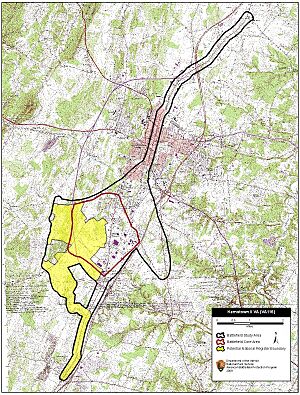Second Battle of Kernstown facts for kids
Quick facts for kids Second Battle of Kernstown |
|||||||
|---|---|---|---|---|---|---|---|
| Part of the American Civil War | |||||||
 Battlefield where the Second Battle of Kernstown took place |
|||||||
|
|||||||
| Belligerents | |||||||
| Commanders and leaders | |||||||
| George Crook | Jubal Early | ||||||
| Units involved | |||||||
| Army of West Virginia | Army of the Valley | ||||||
| Strength | |||||||
| 9,500–10,000 | 13–14,000 | ||||||
| Casualties and losses | |||||||
| 1,200 | 600 | ||||||
The Second Battle of Kernstown happened on July 24, 1864. It was fought near Kernstown, Virginia, close to Winchester, Virginia. This battle was part of the Valley Campaigns of 1864 during the American Civil War.
The Confederate Army of the Valley, led by General Jubal Early, won a big victory. They defeated the Union Army of West Virginia, led by General George Crook. The Union forces were pushed out of the Shenandoah Valley and back into Maryland. This victory allowed General Early to launch the last major Confederate attack into Union territory. They attacked the Baltimore and Ohio Railroad and burned Chambersburg, Pennsylvania. This was done because Union forces had burned civilian homes and farms earlier.
Why the Battle Happened
On July 19, General Early decided to move his Confederate army. He moved from Berryville to a safer spot near Strasburg. During this move, Union forces won a small battle at Battle of Rutherford's Farm. This made Union leaders think the Confederates were leaving the Valley for good. They thought Early was heading to Richmond to help another Confederate army.
Because of this, two large Union army groups left the Valley. They went to help General Ulysses S. Grant at Petersburg, Virginia. Only the Army of West Virginia was left in the Valley. For two days, things were quiet. The armies rested about 15 miles apart.
On July 23, Confederate cavalry attacked Union soldiers at Kernstown. General Early learned from captured soldiers that many Union troops had left. He knew he had to attack the remaining Union forces. This would keep Union soldiers from reinforcing Grant's army.
How the Battle Unfolded
On the morning of July 24, General Early marched his army north. Confederate cavalry met Union cavalry south of Kernstown. Heavy fighting between them began. General Crook was told about the attack. He still believed most of Early's army had left the Valley. So, he sent only two of his army groups to meet the attack.
By early afternoon, both armies' main forces were on the battlefield. The Confederates spread out south of Kernstown. Their sides were protected by high ground and cavalry. General John B. Gordon's group was in the middle. General Stephen Dodson Ramseur's group was on the left. General Gabriel C. Wharton's group was on the right. Early hid his main soldiers in a forest. He sent out cavalry and sharpshooters to trick the Union forces. He wanted them to think only a small force was there.
The Union soldiers stayed mostly around Kernstown. Colonel James A. Mulligan's group was on Pritchard's Hill. This hill was important in an earlier battle. Colonel Joseph Thoburn's group was on Sandy Ridge. Future president Rutherford B. Hayes's group was to the left. General Crook sent Union cavalry to try and get behind the Confederates.
As the fighting started, Union leaders realized they faced a much larger Confederate force. They told General Crook this. But Crook was impatient. He did not believe their reports about the Confederate strength. He ordered Mulligan to attack.
Around 1 p.m., the Union soldiers moved forward. Mulligan's group fought hard at Opequon Church. Their attack was stopped by Gordon's Confederates. As Hayes's group moved to help, General John C. Breckinridge led Wharton's group. They marched into a deep hidden ditch. From there, they suddenly attacked Hayes's group from the side. Hayes's soldiers were surprised and quickly retreated. Many Union soldiers were hurt.
Thoburn's group was supposed to help Mulligan. But they got separated and did not fight much. Gordon's Confederates found a gap in the Union line. They got behind Mulligan's group. With Hayes's group broken, Mulligan was caught between two Confederate groups. He ordered a retreat. Mulligan was badly wounded trying to keep his soldiers from running away completely. The Confederates chased the Union soldiers all the way through Winchester. Their cavalry kept chasing them into West Virginia.
The Union cavalry had tried to go around the Confederates. But they ran into Confederate cavalry. The surprise attack sent the Union cavalry fleeing. They ran towards Martinsburg. When they met Union wagons and cannons retreating, it caused panic. Many drivers left their wagons. Many wagons had to be burned so the Confederates would not get them. As night fell, Confederate cavalry searched for Union soldiers lost in the retreat. Many Union soldiers spent the night scattered in the rain, trying to avoid capture.
What Happened Next
This victory was a big moment for the Confederates in the Valley in 1864. General Crook's defeated army retreated. They crossed the Potomac River into Maryland on July 26. With the Shenandoah Valley clear of Union forces, Early launched his raid. This was the last major Confederate attack into northern territory during the war. They burned Chambersburg, Pennsylvania. This was payback for Union General David Hunter burning civilian homes earlier.
The Confederates also attacked Union forts near Cumberland, Maryland. Because of this defeat and the burning of Chambersburg, General Grant sent more Union troops back to the Valley. He put General Philip Sheridan in charge of Union forces there. This finally turned the tide against the Confederates in the Valley.


